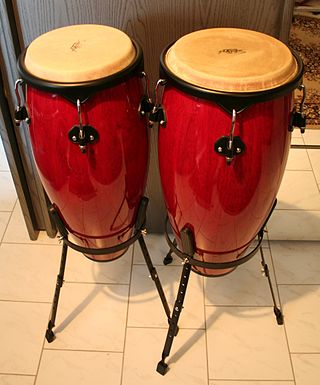
Salsa music is a style of Latin American music, combining elements of Cuban, Puerto Rican, and American influences. Because most of the basic musical components predate the labeling of salsa, there have been many controversies regarding its origin. Most songs considered as salsa are primarily based on son montuno, with elements of mambo, Latin jazz, bomba, plena and guaracha. All of these elements are adapted to fit the basic son montuno template when performed within the context of salsa.
The tres is a three-course chordophone of Cuban origin. The most widespread variety of the instrument is the original Cuban tres with six strings. Its sound has become a defining characteristic of the Cuban son and it is commonly played in a variety of Afro-Cuban genres. In the 1930s, the instrument was adapted into the Puerto Rican tres, which has nine strings and a body similar to that of the cuatro.
Son montuno is a subgenre of son cubano developed by Arsenio Rodríguez in the 1940s. Although son montuno had previously referred to the sones played in the mountains of eastern Cuba, Arsenio repurposed the term to denote a highly sophisticated approach to the genre in which the montuno section contained complex horn arrangements. He also incorporated piano solos and often subverted the structure of songs by starting with the montuno in a cyclic fashion. For his approach, Arsenio had to expand the existing septeto ensemble into the conjunto format which became the norm in the 1940s alongside big bands. Arsenio's developments eventually served as the template for the development of genres such as salsa, songo and timba.
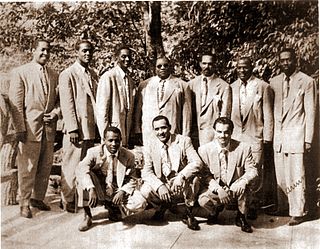
Arsenio Rodríguez was a Cuban musician, composer and bandleader. He played the tres, as well as the tumbadora, and he specialized in son, rumba and other Afro-Cuban music styles. In the 1940s and 1950s Rodríguez established the conjunto format and contributed to the development of the son montuno, the basic template of modern-day salsa. He claimed to be the true creator of the mambo and was an important as well as a prolific composer who wrote nearly two hundred songs.

Los Van Van is one of the leading musical groups of post-revolutionary Cuba. It was founded in 1969 by bassist Juan Formell, who directed the band until his death in 2014. Formell and former band members Changuito and Pupy are some of the most important figures in contemporary Cuban music, having contributed to the development of songo and timba, two popular dance music genres.
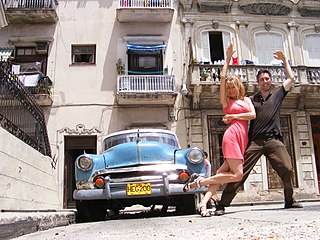
Timba is a Cuban genre of music based on Cuban son with salsa, American Funk/R&B and the strong influence of Afro-Cuban folkloric music. Timba rhythm sections differ from their salsa counterparts, because timba emphasizes the bass drum, which is not used in salsa bands. Timba and salsa use the same tempo range and they both use the standard conga marcha. Almost all timba bands have a trap drummer. Timbas also often break the basic tenets of arranging the music in-clave. Timba is considered to be a highly aggressive type of music, with rhythm and "swing" taking precedence over melody and lyricism. Associated with timba is a radically sexual and provocative dance style known as despelote. It is a dynamic evolution of salsa, full of improvisation and Afro Cuban heritage, based on son, Rumba and mambo, taking inspiration from Latin jazz, and is highly percussive with complex sections. Timba is more flexible and innovative than salsa, and includes a more diverse range of styles. Timba incorporates heavy percussion and rhythms which originally came from the barrios of Cuba.
Afro-Cuban jazz is the earliest form of Latin jazz. It mixes Afro-Cuban clave-based rhythms with jazz harmonies and techniques of improvisation. Afro-Cuban music has deep roots in African ritual and rhythm. The genre emerged in the early 1940s with the Cuban musicians Mario Bauzá and Frank Grillo "Machito" in the band Machito and his Afro-Cubans in New York City. In 1947, the collaborations of bebop trumpeter Dizzy Gillespie and percussionist Chano Pozo brought Afro-Cuban rhythms and instruments, such as the tumbadora and the bongo, into the East Coast jazz scene. Early combinations of jazz with Cuban music, such as "Manteca" and "Mangó Mangüé", were commonly referred to as "Cubop" for Cuban bebop.
Songo is a genre of popular Cuban music, created by the group Los Van Van in the early 1970s. Songo incorporated rhythmic elements from folkloric rumba into popular dance music, and was a significant departure from the son montuno/mambo-based structure which had dominated popular music in Cuba since the 1940s. Blas Egües was the first drummer in Los Van Van, but it was the band's second drummer, José Luis Quintana "Changuito", who developed songo into the world-wide phenomenon it is today.
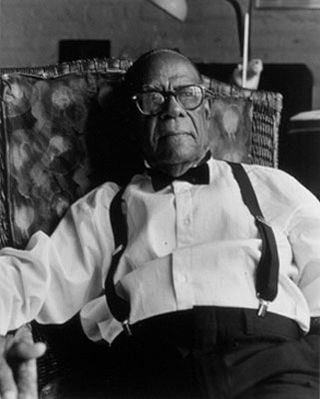
Prudencio Mario Bauzá Cárdenas was an Afro-Cuban jazz, Latin, and jazz musician. He was among the first to introduce Cuban music to the United States by bringing Cuban musical styles to the New York City jazz scene. While Cuban bands had had popular jazz tunes in their repertoire for years, Bauzá's composition "Tangá" was the first piece to blend jazz harmony and arranging technique, with jazz soloists and Afro-Cuban rhythms. It is considered the first true Afro-Cuban jazz or Latin jazz tune.
Irakere is a Cuban band founded by pianist Chucho Valdés in 1973. They won the Grammy Award for Best Latin Recording in 1980 with their album Irakere. Irakere was a seminal musical laboratory, where historic innovations in both Afro-Cuban jazz and Cuban popular dance music were created. The group used a wide array of percussion instruments like batá, abakuá and arará drums, chequerés, erikundis, maracas, claves, cencerros, bongó, tumbadoras (congas), and güiro.
NG La Banda is a Cuban musical group founded by flutist José Luis "El Tosco" Cortés. NG stands for nueva generación. NG La Banda are the creators of timba, the most important popular dance and music genre of the past two decades. Prior to founding NG La Banda, Cortés played in the Afro-Cuban jazz-fusion supergroup Irakere, and the seminal songo band Los Van Van.
In music of Afro-Cuban origin, tumbao is the basic rhythm played on the bass. In North America, the basic conga drum pattern used in popular music is also called tumbao. In the contemporary form of Cuban popular dance music known as timba, piano guajeos are known as tumbaos.
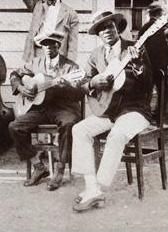
A guajeo is a typical Cuban ostinato melody, most often consisting of arpeggiated chords in syncopated patterns. Some musicians only use the term guajeo for ostinato patterns played specifically by a tres, piano, an instrument of the violin family, or saxophones. Piano guajeos are one of the most recognizable elements of modern-day salsa. Piano guajeos are also known as montunos in North America, or tumbaos in the contemporary Cuban dance music timba.
Paulito FG is one of the original innovators of timba and is a popular salsa and timba performer.
La Charanga Habanera is a timba ensemble from Havana directed by David Calzado. The band has been nominated for awards including the Latin Grammy in 2003 for the album Live in the U.S.A. In 2005 Charanga Habanera was nominated for "Orgullosamente Latino" awards in three categories: best video, best album, and best group. Furthermore, the group has won numerous awards from Cubadiscos and Lucas.
Manuel "Manolín" González Hernández, is a Cuban timba and salsa songwriter, singer, and band leader. Manolín was an amateur songwriter, when NG La Banda's leader José Luis "El Tosco" Cortés discovered him at medical school and famously dubbed him "El Médico de la Salsa".
Manolito y su Trabuco is a salsa and timba group out of Camaguey and Havana, Cuba. It is named for founding member, pianist Manolito Simonet. Trabuco literally means a firearm from the times of the Independence War of 1895 and figuratively refers to anything forceful or strong.
Pedro Nolasco Jústiz Rodríguez, better known as Peruchín, was a Cuban pianist specializing in jazz-influenced Cuban popular music. He was an important figure in the 1950s descarga scene in Havana, and one of the most influential Cuban pianists of the 20th century.
Luis Martínez Griñán, better known as Lilí Martínez, was a Cuban pianist, arranger and composer specializing in the son montuno style. He played in the Conjunto de Arsenio Rodríguez and Conjunto Chappottín. Together with Rubén González and Peruchín, he is said to have "forged the style of modem Cuban piano playing in the 1940s".
The musical structure of Salsa (music) is composed of several components and sections.





